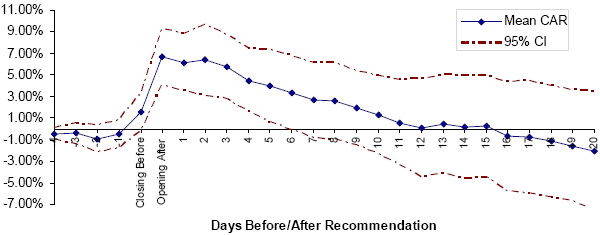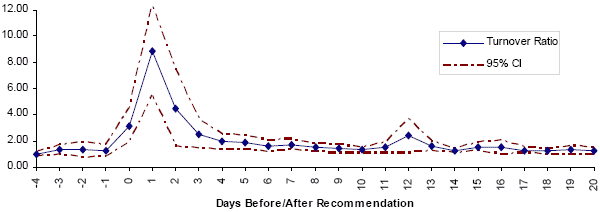Can traders exploit irrational reactions to Jim Cramer’s stock recommendations by viewers of CNBC’s Mad Money? In their March 2006 paper entitled “Is the Market Mad? Evidence from Mad Money“, Joseph Engelberg, Caroline Sasseville and Jared Williams measure the market’s reaction to Mr. Cramer’s buy recommendations. Using a sample of 246 initial recommendations made by Jim Cramer on Mad Money episodes between July 28, 2005 and October 14, 2005, as recorded by YourMoneyWatch.com, they conclude that:
- The average abnormal overnight return for the quartile of recommended stocks with the smallest market capitalizations is 5.2%. This abnormal return dissipates within 12 trading days. These effects diminish with firm size.
- For the quartile of buy recommendations with the smallest market capitalizations, trading volume surges by an average 317% on broadcast date, 890% on the day following broadcast and 451% on the second day after broadcast. These effects also diminish with firm size.
- Short selling of recommended stocks surges in the opening minutes of the trading day following broadcast and remains abnormally high for four days.
- Although CNBC records the show 30 minutes after the market close, Mr. Cramer’s recommendations significantly affect price and trading volume during normal trading hours on the broadcast date.
The following chart, taken from the paper, shows the mean cumulative abnormal return (CAR) with a 95% confidence interval (CI) for the quartile of buy recommendations with the smallest market capitalizations. It shows that when Mr. Cramer issues a buy recommendation for a small stock, the price jumps immediately and then reverts over the next 12 trading days. In fact, price begins to rise abnormally on the broadcast date, suggesting the possibility of pre-broadcast leakage of the recommendations. For firms with larger capitalizations, the effects are less dramatic.

The next chart, also from the paper, shows the turnover ratio (volume compared to its pre-broadcast average) with a 95% confidence interval (CI) for the quartile of buy recommendations with the smallest market capitalizations. It shows that when Mr. Cramer issues a buy recommendation for a small stock, volume spikes dramatically. In fact, volume rises on the broadcast date, suggesting the possibility of pre-broadcast leakage of the recommendations. For firms with larger capitalizations, the effects are less dramatic.

In summary, the losers are the Mad Money viewers who buy recommended stocks at the open the next day. The winners are the market makers and arbitrageurs who sell the overpriced recommendations on day 1, and the traders who sell them on days 2 through 12.